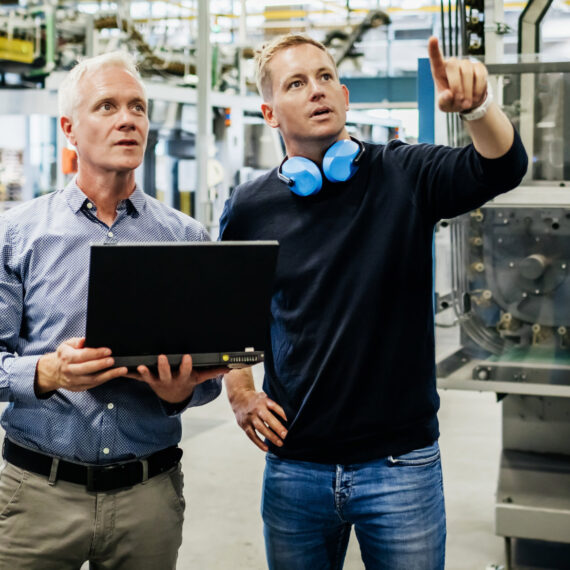The future for industrial companies lies not only in selling more products, but also in using data-based services to tap into new markets – an approach that has become known as ‘servitisation’. This opens the door to innovative business models and sustainable growth in manufacturing. Find out here what servitisation is all about and how to get started with it.
Digital Manufacturing Services
Industry leaders have increased their productivity by up to 90% through digital transformation. Swisscom specialists support you in the digitalisation of production.
Pay only for operating hours instead of buying the aircraft engine: this business model pursued by Rolls-Royce, the British airplane turbine manufacturer, became known as ‘Power-by-the-Hour’ and turned out to be a pioneering step. Airlines could calculate costs based on flying hours and were (mostly) spared from unexpected business interruptions. Rolls-Royce, in turn, was able to optimise maintenance to take advantage of economies of scale.
The ‘Power-by-the-Hour’ approach precisely describes the concept of servitisation. Manufacturers are adding sensors to their physical machines, devices and components so that they can offer data-based services ‘as a service’. Instead of buying a product, customers get a solution at a transparent price.
Technical progress is fostering manufacturing innovation
Digitalisation is the technical driver behind servitisation. Sensors and radio networks – the Internet of Things (IoT) – continuously report information about the state of production facilities and their components, their use and the operating environment. Manufacturers can use this data to optimise operation or servicing – think ‘predictive maintenance’. However, the data collected also facilitates the creation of completely new business models. For example, Franke coffee machine displays can be used to call attention to new or seasonal drinks and promotions via remote access.
Also because of its disruptive potential, the Fraunhofer Institute for Cognitive Systems (Fraunhofer IKS) identifies servitisation as an important component of Industry 4.0 and has designated it a research focus. The future example of self-driving cars booked on demand and billed after use shows the disruption that is possible with servitisation. Back in their day, the Rolls-Royce engineers could only dream of such approaches: the ‘Power-by-the-Hour’ concept dates back to 1962.
Servitisation – the path to the future of manufacturing?
The intention behind the use of servitisation in the manufacturing industry is to better meet customer needs in the sense of vertical integration, while alleviating cost pressures. ‘Customers primarily want to solve a problem with the machines and equipment they buy and not just purchase hardware,’ says Hanspeter Groth, Industry Leader for Manufacturing at Swisscom. ‘The better suppliers understand the customer problem and optimise their products to solve it, the better positioned they will be in the market.’
This optimisation can be achieved through more efficient operation of installations, equipment and components, as well as through additional (data-based) services that promise added value in downstream markets. With intelligent service add-ons, new business models can be tapped and thus new revenue streams created. In addition, the services can contribute to better margins through improved cost/benefit ratios.
Driving new business models: practical examples of servitisation
Digitalisation has opened up a completely new dimension to the well-known servitisation approach. While factors such as product quality, low failure rates and efficient maintenance are still important, the data collected and processed will make the difference today and in the future. It can be used to draw new conclusions about the use of installations, equipment and components and thus to exploit the opportunities of targeted vertical integration. These three examples show how this looks in practice:
- With its Nuron battery platform, tool manufacturer Hilti has introduced a standardised battery system for a large number of different power tools used in construction. What’s more, the batteries collect information about how and to what degree the tools are used and transmit this data to the Fleet Management programme in the cloud when charging. Hilti customers can then optimise deployment planning and reduce downtime.
Schaerer and Franke, manufacturers of professional coffee machines, have connected up their devices and equipped them with sensors. As a result, coffee providers are kept up to date on the use of the coffee machines and can, for example, optimise their product range and locations. The screens enable enhanced interaction with coffee consumers (e.g. for upselling).- Schindler offers connectivity services for its escalators and lifts. As a result, lift operators and facilities managers always know the operating condition of the equipment and are kept informed about necessary maintenance measures. This ensures safe operation, simplifies upkeep and speeds up fault resolution.
First steps to servitisation for manufacturing companies
Servitisation may take place gradually or can also emerge as a disruptive business model. Such transformation processes need to be planned strategically and require the involvement of management, employees and users or end customers. Only by taking all these perspectives into account can servitisation become a sustainable success model.
Alexandre Salzmann, Head of Digital Business and a servitisation expert at Swisscom, recommends manufacturing companies follow these three steps, which will make it easier for them to get started:
Step 1: Take stock
- Where do we stand at this time compared to the industry?
- How can servitisation benefit our company?
- Which services are suitable for vertical integration and which are not? Where does the greatest potential lie in our company?
Step 2: Involve end customers (outside-in view)
- What are the needs of our customers and their customers?
- What services can our company offer to meet these and create a win-win situation? It’s important to understand the added value the services will provide to customers in downstream markets and the resulting usage profiles.
Step 3: Establish servitisation within the company
- How can I convince our organisation and management of the merits of servitisation?
- How can I integrate servitisation into our business strategy?
- How can I create the necessary technical, legal and commercial conditions for the new strategy? This includes, among other things, software development lifecycle management, data platforms (in the cloud), service level agreements, subscription models and governance.
- How will I implement this strategy (e.g. think big – start small or fail fast and learn)?
It’s worth being an early mover with servitisation
Given the potential of servitisation, Alexandre Salzmann believes manufacturing companies should address it now so that they can open up new markets: ‘Planning and implementation take time.’ A first step might be to take stock of where the company is now in order to evaluate possible business models, for example in a workshop. After all, if data is the new gold, there is no excuse for not turning it into money before competitors do.
White paper: Your path to a smart factory
Would you like to digitise your machines, systems and processes easily and sustainably? This white paper explains how you can approach shopfloor digitisation in your company.





